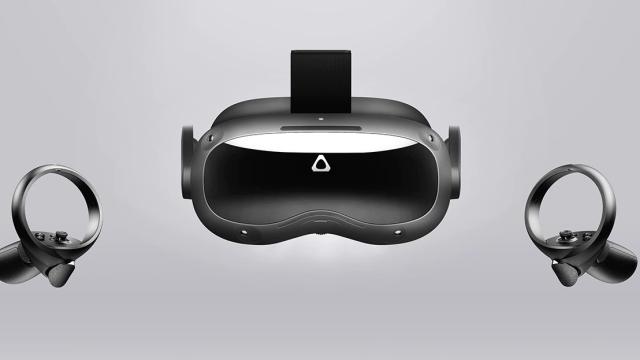HTC doesn’t want you confusing its new VIVE Focus 3 virtual reality headset for entry-level consumer gear like the Meta Quest 2.
Despite sharing certain similar aesthetic philosophies, the two headsets couldn’t be more different. The Quest 2 is designed for the consumer market, those who plan to muck about with VR as a novelty in the comfort of their own home. That’s not where the VIVE Focus 3 lives.
The VIVE Focus 3 lives in commercial spaces, and is designed to change the face of interactive spaces. Let’s use Zero Latency as an example — the Australian VR leisure outfit has recently signed a major deal with HTC to use VIVE Focus 3 headsets as its primary VR device in most of its major locations around the world. To hear HTC tell it, what tempted Zero Latency into making this deal was the chance to do away with the now well-known backpack tech that powers its interactive VR spaces.
For the uninitiated, Zero Latency is, in a sense, what laser tag looks like in 2022. Zero Latency uses a large retail space full of real-world obstacles as a map. It uses a 1:1 replica of this map when constructing specialised game software so that, when players don a VR headset and step into one of ZL’s virtual worlds, everything they see before them is replicated in the real world. If you walk up a ramp in the game, that ramp will be beneath your feet in real life, building an extra layer of immersion. The trade-off for doing this has always been a “backpack” that players must wear at all times. Inside the backpack, a powerful gaming laptop powers the whole experience.
The HTC VIVE Focus 3 does away with the backpack. Rather than cart game data around player to player, and run it in real-time, companies like Zero Latency can now use individual headsets and stream the game data over powerful Wi-Fi. The headset is a single-piece unit with a removable battery in the headband. When one battery runs down, a staff member can quickly rip it out, replace it with a freshly charged unit, and get the player moving again.
Because the VIVE Focus 3’s ambitions are almost entirely commercial, there aren’t that many games available for it. HTC wants to get headsets like this into the hand sof clients that can put it to best use — less so the kinds of consumers looking to show off VR to friends and family at Christmas.
What I felt during my short hands-on session with the device at PAX Aus was a device with a considerable amount of power behind it. Its twin 5K lenses (via a pair of 2.55″ LCD panels running at 90Hz) created a very clear, smooth image, and its wide 120-degree FOV created a sense of envelopment. Response times were rapid, close to instant. The fit was comfortable and uses magnets to hold adjustable components like the glasses buffer in place, rather than slotting them into notches that could lead to wear and tear with regular removal. The headband carries the bulk of the weight, though the headset has been well-balanced from front to back. There’s none of the familiar downward pull of the Quest 2’s elastic headband, the HMD wanting to follow gravity’s pull. Instead, it sits just off the bridge of your nose, the weight suspended comfortably above your head.
As an all-in-one headset, the Focus 3 also does away with the VIVE’s famous lighthouses, beacon-like devices that were to be placed around a room to triangulate movement and position. Like the Quest 2, the VIVE Focus 3 uses an array of cameras across its fascia to “see” and track its surrounds. The replaceable battery and wireless streaming tech mean it cuts the cord entirely, allowing a full range of movement within its predetermined zone.
And so, here HTC finds itself in an odd position — with a ripper headset that would be the envy of most domestic manufacturers, unavailable at such a level. Even enthusiasts, who can look at this headset and see the value it represents, on paper and in practice, are left staring through the proverbial candy shop window wondering why they have been forsaken.
Where most other hardware makers in the VR space are pushing for greater accessibility and competitive pricing in the home market, HTC’s interests seem to lie elsewhere. If it has indeed identified fertile market ground, it won’t be long before the others attempt to follow suit.
Anyway, your regular holiday session at Zero Latency is about to become much easier on your back, and for that alone we must be thankful.

Leave a Reply